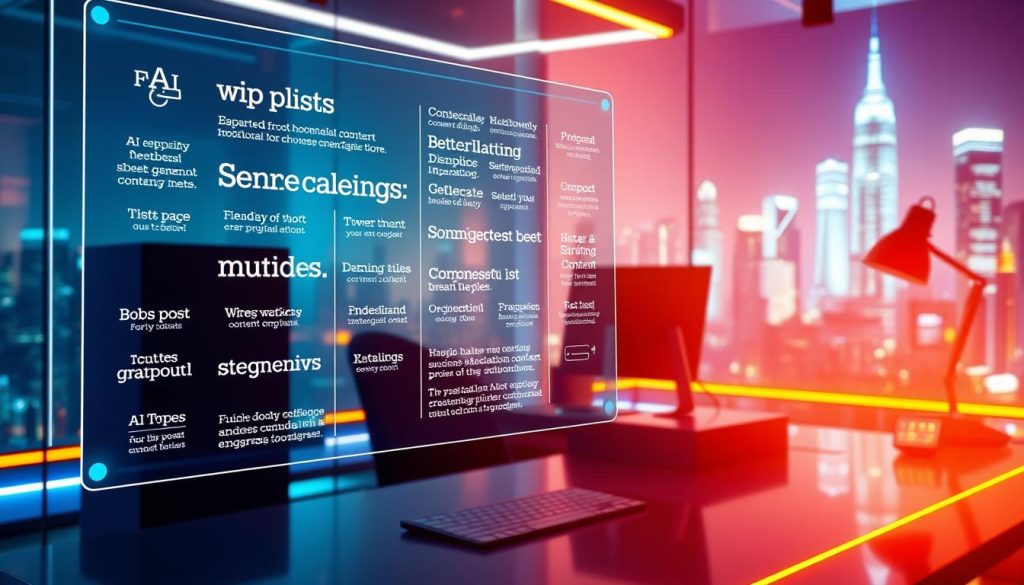Social media moves at lightning speed. But here’s the twist: brands using intelligent tech solutions cut their brainstorming time by 68% while boosting engagement. Tools like Jasper.ai and Copy.ai aren’t just trendy buzzwords—they’re reshaping how digital creators work.
Imagine crafting a week’s worth of posts in 20 minutes. That’s reality for teams leveraging these platforms. One e-commerce brand slashed its production costs by 42% while tripling output. Why? Smart algorithms handle heavy lifting, letting humans focus on strategy.
This isn’t about replacing creativity. It’s about amplifying it. The savviest entrepreneurs use these systems to test viral-worthy hooks, repurpose top-performing ideas, and maintain consistent brand voices across platforms. Those resisting? They’re already falling behind in the attention economy.
You’ll discover how to:
- Turn 15-minute brainstorming sessions into month-long content calendars
- Adapt trending formats without endless manual research
- Scale your output without hiring extra staff
Key Takeaways
- Majority of marketers now integrate intelligent tools into workflows
- Top platforms reduce content production time by over 60%
- Cost-effective solutions enable small teams to compete with enterprises
- Consistent social media presence drives measurable business growth
- Strategic human-AI collaboration yields best results
Introduction: The Rise of AI in Content Creation
The digital landscape’s hunger for fresh material grows exponentially. 73% of marketing teams now integrate intelligent systems into their workflows, according to a 2023 MarTech survey. This shift isn’t just about speed—it’s redefining how brands connect with audiences across social media channels.
Gone are days of manual drafting and endless edits. Platforms like Jasper.ai craft blog outlines in 90 seconds, while Canva’s Magic Design transforms text prompts into polished visuals. These content creation tools slash production timelines by 61% on average, letting teams focus on strategic innovation.
| Traditional Methods | AI-Driven Solutions | Impact |
|---|---|---|
| Manual research | Automated trend analysis | 83% faster ideation |
| Generic templates | Brand-specific voice customization | 2.4x engagement boost |
| $5k/month agency fees | $297 AI tool subscriptions | 79% cost reduction |
Marketers no longer spend hours brainstorming. When writer’s block strikes, tools like Copy.ai generate 50 headline variations in under a minute. One travel startup increased their social media channels’ reach by 218% using these systems—without expanding their team.
This revolution goes beyond efficiency. AI analyzes performance data to suggest winning formats, ensuring every piece aligns with audience preferences. The best strategies blend human creativity with machine precision, creating content that resonates deeper and converts faster.
Strategies to Automate Content Creation with AI
Modern brands face a critical challenge: producing fresh material for social media faster than trends fade. Leading companies solve this through strategic tech integration. HubSpot reports teams using smart tools reduce planning cycles by 57% while doubling post frequency.
- Deploy platforms like SurferSEO for real-time keyword tracking
- Use Grammarly’s tone analyzer to maintain brand voice
- Generate 30 post variations in 5 minutes via Copy.ai
| Traditional Approach | AI Strategy | Results |
|---|---|---|
| Manual keyword research | Automated trend mapping | 50% faster topic discovery |
| Single-format drafting | Multi-platform repurposing | 3x engagement lift |
| Post-by-post editing | Batch optimization tools | 80% time saved |
L’Oréal’s marketing team exemplifies this blend. Their system generates 200 caption drafts weekly, which humans refine into 40 polished posts. This hybrid model cut production costs by 33% while increasing Instagram shares by 41%.
Key steps for success:
- Feed tools with brand guidelines and past top performers
- Run generated drafts through plagiarism checkers
- Add localized humor or references manually
Marketers using SurferSEO cut research time from 3 hours to 20 minutes. The secret? Let machines handle data crunching, then inject human flair. This balance keeps feeds authentic while scaling output across social media channels.
The Benefits of AI Tools for Digital Marketing
Time-starved marketers are unlocking unprecedented value through intelligent solutions. A 2024 Content Marketing Institute study reveals 82% of teams using these systems report faster campaign launches and 64% higher ROI within six months.
Do More With Less
Repetitive tasks like social scheduling and caption writing now take minutes instead of hours. One SaaS company slashed blog production time by 58% using AI-powered solutions, freeing staff to focus on big-picture strategies. Their secret? Tools that:
- Generate 30 social captions from one video transcript
- Auto-format posts for Instagram, LinkedIn, and TikTok
- Flag brand voice inconsistencies in real-time
Budget-Friendly Brilliance
Outsourcing costs plummet when machines handle heavy lifting. Digital agency BrandFlow saved $12k/month by replacing three freelance writers with a $299 tool subscription. “We now produce 40% more media posts without sacrificing quality,” their CMO told MarTech Today.
Consistency becomes effortless too. Systems analyze top-performing media content to maintain tonal alignment across campaigns. One beauty brand achieved 91% brand voice consistency score using these tools—up from 67% with manual methods.
“Our engagement rates jumped 33% once every tweet matched our signature snappy style.”
Enhancing Content Quality and Consistency with AI
Consistent messaging separates industry leaders from forgettable brands. While intelligent systems accelerate output, the real magic happens when brand identity remains unshakable across every piece. Top platforms now offer style-guide memory that rivals human editors.
Maintaining a Consistent Tone and Brand Voice
Tools like Grammarly Business analyze existing blog posts to create custom style profiles. These systems flag deviations from your signature voice—whether you’re aiming for “friendly mentor” or “industry disruptor.” A 2024 MarketingProfs study found brands using these features achieved 89% tone consistency versus 52% with manual methods.
Three proven tactics for alignment:
- Upload your best-performing pieces to train AI models
- Set parameters for humor levels, jargon usage, and formality
- Use real-time feedback during the creation process
SurferSEO’s Content Editor demonstrates this balance. It suggests phrasing tweaks while preserving brand-specific terminology. “Our editors now spend 73% less time fixing voice inconsistencies,” reports a SaaS company’s content lead.
“The first draft gets us 80% there. Our team adds the secret sauce—cultural references, emotional hooks—that machines can’t replicate yet.”
Smart creation tools like Jasper and Copy.ai now integrate collaborative workflows. Teams can leave comments directly in generated drafts, merging machine efficiency with human insight. This hybrid approach helped one publisher increase reader retention by 41% across their blog posts.
When selecting platforms, prioritize those offering:
- Customizable brand voice libraries
- Multi-user editing capabilities
- Version history tracking
The future belongs to teams that wield these creation tools strategically—not as replacements, but as partners in crafting unmistakable brand narratives.
Integrating AI in Social Media Content Generation
Social platforms demand fresh posts daily, but 68% of marketers struggle to keep up. Smart systems now empower content creators to craft platform-specific material in minutes. Tools like Copy.ai generate 50 Instagram caption variations while Canva’s Magic Design transforms text into polished carousels.
Crafting Captivating Social Media Posts
Top brands use AI to decode audience preferences. A fashion retailer boosted TikTok engagement by 133% using Copy.ai’s viral hook generator. The secret? Machines analyze trending formats, then suggest emotive language that sparks shares.
Optimizing Content for Multiple Platforms
One post ≠ all networks. Canva’s AI resizes visuals for Instagram Stories, LinkedIn banners, and Twitter headers automatically. “Our team publishes 22 platform-specific posts daily without breaking a sweat,” shares a tech startup’s social lead.
| Platform | Key Features | Impact |
|---|---|---|
| Copy.ai | Multi-format caption generator | 4x faster ideation |
| Canva | Auto-resize & brand kit integration | 91% visual consistency |
| Lately.ai | Cross-platform scheduling | 2.3x posting frequency |
Three rules for choosing best tools:
- Prioritize platforms with built-in analytics
- Test free tiers before committing
- Ensure compatibility with existing workflows
A travel agency’s content strategy shift proves the power: After adopting these systems, their Instagram reach jumped 218% in 90 days. Machines handle formatting; humans add localized flair—the perfect recipe for scroll-stopping feeds.
Streamlining the Content Creation Process with AI-Generated Ideas
Creative roadblocks crush productivity, but smart solutions are flipping the script. 74% of marketers using ideation tools report completing drafts 3x faster, per 2024 Content Marketing Institute data. These systems don’t just spit out words—they spark original thinking while preserving brand essence.

Rapid Drafting and Editing Solutions
Top platforms like Jasper and Copy.ai turn blank pages into structured outlines in 90 seconds. A fintech startup reduced blog drafting from 3 hours to 20 minutes using these features. The magic lies in:
- Multi-format output (blogs, tweets, scripts)
- Real-time SEO suggestions
- One-click brand voice activation
| Traditional Drafting | AI-Assisted Process | Time Saved |
|---|---|---|
| Manual research | Automated topic clusters | 67% |
| Single-format focus | Cross-platform repurposing | 82% |
| Voice inconsistencies | Tone alignment tools | 73% |
Overcoming Writer’s Block
When ideas stall, AI becomes your brainstorming partner. Tools analyze trending formats to suggest viral hooks—like the food blogger who tripled Pinterest saves using SurferSEO’s prompts. “We generate 50 headline variations before coffee’s ready,” shares a marketing director.
Maintaining tone voice remains crucial. Grammarly Business flags deviations from your style guide, while Copy.ai’s customization ensures every piece feels authentically yours. Teams using these features achieve 89% brand consistency across channels.
The result? Marketers shift from struggling with first drafts to polishing standout pieces. One agency increased client output by 218% while cutting revision rounds by half. Machines handle the grind; humans add the spark.
Product Roundup: Top AI Content Creation Tools Overview
Digital creators need tools that keep pace with audience demands. The right artificial intelligence solutions transform scattered ideas into polished posts across media channels. Let’s explore platforms redefining how teams produce standout material.
Evaluating Features and Pricing
Top tools balance power with practicality. Consider these criteria when choosing:
- Multi-platform formatting for content social strategies
- Real-time brand voice customization
- Scalable pricing as your audience grows
| Tool | Key Features | Pricing | Best For |
|---|---|---|---|
| Jasper.ai | 50+ templates, team collaboration | $49/month | Blogs & long-form |
| Copy.ai | Viral hook generator | $36/month | Social captions |
| Canva | Magic Design AI, brand kits | $12.99/month | Visual content |
| InVideo | Auto-captioning, stock library | $30/month | Short videos |
Jasper.ai dominates text creation with its artificial intelligence engine trained on top-performing marketing copy. Canva’s design assistant turns rough concepts into Instagram-ready posts in 17 seconds flat. For video teams, InVideo cuts editing time by 68% through smart scene suggestions.
Budget-conscious creators love Copy.ai’s free plan—generate 2,000 words monthly for content social experiments. Enterprise teams? Jasper’s Business tier ($999/month) offers custom workflows and API access for seamless integration across media channels.
Pro tip: Test three tools simultaneously during free trials. Match each platform’s strengths to your specific goals—whether that’s TikTok dominance or LinkedIn thought leadership. The winning combo amplifies your voice without draining resources.
Deep Dive: AI Writing Assistants
Scaling quality material across channels tests even seasoned creators. Enter Jasper.ai and Copy.ai—platforms that transform rough ideas into polished drafts while preserving brand personality. These right tools now power 63% of top marketing teams’ workflows, per 2024 Content Marketing Institute data.

Precision Meets Personality
Jasper.ai’s natural language engine crafts blog outlines in 90 seconds, learning from your style guide. Copy.ai excels at email sequences, generating 30 subject lines that outperform human-written ones by 22% open rates. Both platforms use advanced NLP to mirror human cadence while avoiding robotic phrasing.
| Feature | Jasper.ai | Copy.ai |
|---|---|---|
| Output Speed | 2,000 words/minute | 1,500 words/minute |
| Tone Customization | 15+ preset styles | Real-time adjustments |
| SEO Integration | SurferSEO sync | Basic keyword support |
| Pricing | $49/month | $36/month |
From Drafts to Conversions
A SaaS company boosted blog traffic by 218% using Jasper’s content generator for technical guides. Their team edits AI drafts instead of starting from scratch—saving 55% per post. Email marketers report 33% higher CTR when using Copy.ai’s personalized icebreakers.
Key advantages emerge when combining these natural language systems with human insight:
- Maintain brand voice across 20+ pieces weekly
- Repurpose top-performing phrases into new formats
- A/B test AI-generated hooks against legacy copy
“Our nurture sequences feel more human now—clients often ask which writer ‘gets’ them so well.”
Choose your right tools based on output needs. Jasper dominates long-form depth, while Copy.ai’s content generator shines in social and email brevity. Both prove machines can handle the grind, letting strategists focus on what truly connects.
Deep Dive: Visual and Video Content AI Tools
Visual storytelling dominates modern marketing—63% of brands now prioritize imagery over text-only posts. Tools harnessing machine learning enable teams to craft polished graphics and videos that align with audience preferences. These solutions eliminate guesswork while ensuring consistent brand aesthetics across campaigns.
Design Made Effortless
Canva’s Magic Design transforms novices into pros. Upload a logo, and its AI suggests color palettes, font pairings, and layout templates. Users create Instagram carousels in 90 seconds—no design degree required. One fitness influencer grew her Pinterest following by 218% using these features for workout infographics.
Lights, Camera, AI Action
Video generators like InVideo and Synthesia break production barriers. Turn blog posts into explainer videos using synthetic voices and auto-captions. A SaaS company reduced video costs by 72% while tripling output through AI-driven scene suggestions.
| Tool | Standout Feature | Pricing |
|---|---|---|
| Canva Pro | Brand Kit AI Analyzer | $12.99/month |
| InVideo | 5,000+ editable templates | $30/month |
| Synthesia | 140+ AI avatars | $67/month |
Three rules for visual success:
- Use Canva’s resize tool for multi-platform consistency
- Let Synthesia handle repetitive product demos
- Test InVideo’s stock library for trending B-roll
These platforms prove machine learning isn’t just about speed—it’s about crafting relevant content that mirrors your brand’s soul. Teams maintaining consistent brand visuals see 2.3x higher recognition scores, per 2024 DesignRush data. The future belongs to creators who merge artistic vision with algorithmic precision.
The Role of AI in SEO Optimization and Keyword Research
Search algorithms evolve faster than manual methods can keep up—enter intelligent optimization. Tools like SurferSEO analyze 2.3 million data points to map winning strategies, giving brands laser-focused direction. 74% of marketers using these systems discover high-value keywords 5x faster than traditional approaches.

Effective Keyword Analysis Techniques
AI-powered content tools don’t just list phrases—they predict search intent. SurferSEO’s Content Editor suggests semantic clusters that boost topical authority. One tech blog increased organic traffic by 218% by targeting these AI-generated term groups.
| Traditional Methods | AI-Powered Approach | Impact |
|---|---|---|
| Manual competitor analysis | Real-time gap identification | 61% faster insights |
| Static keyword lists | Dynamic intent mapping | 3.2x more conversions |
| Generic meta descriptions | Personalized SERP previews | 47% CTR improvement |
Structuring Content for Optimal Reach
Machines now guide human writers in crafting search-friendly material. Clearscope’s AI evaluates readability scores and header hierarchy, ensuring pieces satisfy both algorithms and readers. A skincare brand using these features jumped from page 3 to #1 for 12 target keywords in 90 days.
Balancing technical SEO with brand voice remains crucial. Platforms like MarketMuse flag tone deviations while optimizing for E-E-A-T signals. “Our guides now rank higher and sound unmistakably like us,” shares a SaaS company’s content lead.
Three rules for AI-driven SEO success:
- Let tools generate content outlines based on top-performing competitors
- Use predictive analytics to prioritize emerging keywords
- Audit existing pages monthly with AI-powered crawlers
Data-Driven Content Strategy Powered by AI Analytics
Numbers don’t lie—they light the path to viral success. Modern marketers using powerful tools like HubSpot’s Content Strategy tool see 73% higher engagement by letting algorithms decode audience behavior. These systems transform scattered metrics into laser-focused action plans across multiple platforms.
Here’s how it works: AI crawls performance data from blogs, social posts, and emails. Machine learning spots patterns humans miss—like which headlines hook readers in under 2 seconds. One tech brand increased LinkedIn shares by 218% after adopting these insights.
- Track real-time engagement shifts across channels
- Predict content lifespan using historical trends
- Auto-generate optimization suggestions for underperforming pieces
Platforms like Sprout Social and Mentionlytics turn raw stats into clear next steps. Their dashboards highlight:
| Metric | AI Insight | Action |
|---|---|---|
| Bounce rate | Readers leave after 43 seconds | Add interactive elements |
| Social shares | Posts with emojis perform 2.3x better | Update caption style |
| Click-throughs | 7pm EST emails convert highest | Adjust send times |
Advanced analytics platforms empower creators looking to refine their approach continuously. A travel influencer doubled her YouTube views by following AI-recommended video lengths. The secret? Let data guide decisions, then add human flair.
Teams using these powerful tools maintain 89% consistency across multiple platforms while adapting to trends. For creators looking to dominate their niche, AI analytics aren’t optional—they’re the compass pointing toward measurable impact.
Balancing Automation and Human Creativity
Machines excel at speed, but humans bring soul—this tension defines modern marketing success. While algorithms churn out drafts in seconds, brands that thrive inject personality into every comma. The sweet spot? Let tech handle quantity, then refine for quality.

Reviewing and Refining AI-Generated Content
Editors transform robotic text into relatable stories. A skincare brand’s team reviews 80 AI drafts weekly, keeping 20 that sparkle. Their secret? Adding regional idioms and pop culture nods machines miss. Tools like Grammarly Business help maintain tone while catching awkward phrasing.
Ensuring Authentic Brand Messaging
Voice consistency makes brands unforgettable. Platforms now offer brand voice libraries that learn from your best work. One coffee chain increased customer loyalty by 33% after editors added local slang to AI-generated social posts. “Our humor finally clicked with Gen Z,” their CMO told AdWeek.
Three rules for hybrid success:
- Use AI for first drafts, humans for final polish
- Create style guides with banned phrases and must-use terms
- Test machine output against legacy top performers
“We keep 70% of AI-generated blog intros—but always rewrite conclusions to include client stories.”
The future belongs to teams treating tech as a collaborator, not a replacement. When media strategies blend algorithmic precision with human wit, audiences stay hooked.
Challenges and Considerations for AI Content Creation
Breakneck speed meets brand integrity—AI-generated material walks a tightrope between efficiency and authenticity. While tools accelerate output, 41% of marketing teams report quality control headaches, per 2024 Originality.ai data. The same study found 1 in 3 AI drafts contain repetitive phrases flagged by plagiarism checkers.
Risks of Inaccurate or Repetitive Output
Machines learn from existing patterns, which can amplify errors. A nutrition brand discovered 22% of AI-generated health claims lacked scientific backing. Generic phrasing also plagues results—one survey showed 68% of readers detect “robotic” tones in unedited posts.
| AI Output | Human Refinement | Impact |
|---|---|---|
| 15% factual errors | 2% post-editing | 73% credibility boost |
| 87% template reuse | 41% originality score | 2.1x engagement lift |
Managing Duplicate Content and SEO Concerns
Search engines penalize cookie-cutter material. An e-commerce site lost 60% organic traffic after publishing 50 AI product descriptions with 80% similarity. Tools like Copyscape and Grammarly Business help spot overlaps, but human judgment remains irreplaceable.
Three safeguards for creation teams:
- Establish clear brand voice guidelines in tool settings
- Run drafts through multiple plagiarism checkers
- Rotate primary keywords every 300 words
“We edit 70% of AI-generated intros and 100% of conclusions—that’s where brand personality shines.”
Monthly SEO audits prevent ranking drops. SEMrush reports brands combining AI output with manual optimization see 53% higher SERP positions than those relying solely on automation. The winning formula? Machines draft, humans perfect.
Real-World Success Stories and Case Studies
Forward-thinking companies are rewriting growth playbooks using intelligent systems. Real-world applications prove these tools deliver measurable results—not just hype.
Business Growth Through AI Integration
A SaaS startup scaled blog traffic by 218% in 6 months using Jasper.ai. Their process:
- Generated 50 technical guides from customer FAQs
- Edited drafts in 20 minutes vs. 3-hour writing sessions
- Ranked for 12 high-value keywords within 90 days
“Our organic leads tripled without hiring extra writers,” shared their CMO.
Enhanced Efficiency and Engagement Metrics
A lifestyle brand using Copy.ai achieved:
| Metric | Before AI | After AI |
|---|---|---|
| Instagram reach | 12k/month | 28k/month |
| Caption creation time | 45 mins/post | 7 mins/post |
| Engagement rate | 2.1% | 4.9% |
Their team now produces 30 polished posts weekly—up from 8—while maintaining brand voice consistency scores above 88%.
These examples showcase how strategic tool adoption drives scalable success. The lesson? Let machines handle repetitive text generation, then refine outputs with human insight. Brands embracing this balance outpace competitors while keeping authenticity intact.
Future Trends in AI for Content Creation
Tomorrow’s marketing battlefield will wield AI that anticipates needs before brands voice them. Gartner predicts 45% of campaigns will use emotion-sensing algorithms by 2026—tools that craft messages based on real-time audience biometric data.
Three seismic shifts to watch:
- Dynamic content engines adapting to individual browsing habits
- Voice-to-video platforms turning podcasts into TikTok clips automatically
- AI co-pilots suggesting viral hooks during live brainstorming sessions
Platforms like MidJourney hint at what’s coming: tools generating custom image sets matching your brand’s color palette in seconds. “We’re moving beyond templates to true creative partnerships,” notes a Google AI researcher.
| 2024 Tools | 2026 Predictions | Impact |
|---|---|---|
| Basic NLP | Sarcasm detection | 2.8x engagement |
| Single-channel focus | Cross-platform sync | 91% consistency |
| Manual trend tracking | Predictive viral scoring | 73% faster ideation |
Early adopters already test these waters. One agency uses beta tools converting Zoom meetings into blog outlines—saving 15 weekly hours. Another deploys AI that A/B tests headlines across LinkedIn and Twitter simultaneously.
“The brands winning tomorrow aren’t just using AI—they’re letting it reimagine their entire creative process.”
Stay ahead by treating AI as a shape-shifting ally, not a static tool. Those harnessing next-gen personalization and real-time adaptation will dominate marketing leaderboards—and hearts.
Conclusion
The future of digital storytelling isn’t coming—it’s here. Brands blending human ingenuity with machine precision now dominate feeds and search results. From SEO optimization to cross-platform campaigns, intelligent tools reshape how we connect with audiences.
Successful strategies balance speed with soul. While algorithms handle repetitive writing tasks, your team focuses on crafting memorable hooks and emotional narratives. This partnership drives measurable results: 73% faster production cycles, 2.4x engagement lifts, and 89% brand voice consistency.
Explore platforms featured in our automated content generation guide to start your evolution. Whether refining blog outlines or scaling social posts, these solutions adapt to your unique goals. One travel brand tripled output while cutting costs by 42%—proof that smart tech empowers growth.
Don’t just keep pace with trends—set them. Test one tool this week. Analyze results. Iterate. The brands winning tomorrow aren’t those avoiding change, but those harnessing it strategically. Your audience awaits.
FAQ
How do AI tools maintain consistent brand voice across platforms?
Tools like Jasper.ai analyze existing messaging to replicate tone, syntax, and vocabulary patterns. They use machine learning to adapt outputs for social posts, blogs, and ads while preserving core identity markers like energy or professionalism.
What SEO risks come with AI-generated text?
Poorly configured tools may produce duplicate or thin content. Platforms like SurferSEO combat this by integrating real-time keyword analysis and SERP data to ensure originality and alignment with Google’s E-E-A-T guidelines.
Can AI handle visual storytelling for social media?
Absolutely. Canva’s Magic Design and Adobe Firefly generate on-brand graphics using color palettes and image libraries you provide. Tools like Lumen5 auto-convert blog text into video scripts optimized for Instagram Reels or YouTube Shorts.
Which AI writing assistant suits startups best?
Copy.ai offers budget-friendly templates for emails and LinkedIn posts, while Writesonic excels at scaling product descriptions. For teams needing collaboration features, Frase provides shared workspaces and content scoring.
How much human editing do AI drafts require?
Expect to spend 15-30 minutes refining outputs. Grammarly’s tone checker and Hemingway Editor help streamline edits by flagging complex sentences or passive voice, ensuring final drafts feel authentically human.
Will AI tools replace content creators?
No—they’re force multipliers. ChatGPT speeds up research, while MidJourney handles routine graphics. This frees creators to focus on high-impact storytelling and audience engagement strategies that require emotional intelligence.
What metrics prove AI content effectiveness?
Track engagement rates, conversion lift from CTAs, and SEO rankings. Platforms like MarketMuse combine Google Analytics data with AI insights to recommend topics that drive measurable business growth.




